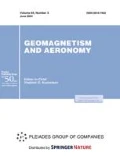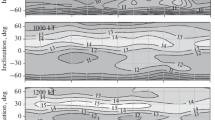Abstract—
Changes in the structure of the summer equatorial anomaly of electron density with local time and longitude at high solar activity are considered in detail according to topside sounding data from the Interkosmos-19 satellite. It is shown that the equatorial anomaly starts to develop from ~0800 LT, when the winter (southern) crest is formed. The summer (northern) crest is ~2 h behind in development. It is formed at the background of a low latitudinal foF2 maximum. In the daytime, the northern crest is ~3° farther from the geomagnetic equator than the southern one. The crest position changes greatly with longitude. A local maximum is observed in the development of the equatorial anomaly at 1400 LT. It is particularly pronounced in the Eastern Hemisphere. The foF2 value above the geomagnetic equator and anomaly intensity change with longitude at 1200–1400 LT according to the changes in the vertical plasma drift W. A local minimum is observed in the development of the equatorial anomaly at 1800 LT. The anomaly intensity then increases to a maximum 1.5–2.0 h after the evening peak in W. Longitudinal foF2 variations and the anomaly intensity in the interval 2000–2200 LT are also associated with W variations. The anomaly intensity decreases after the maximum, and the crests decrease in magnitude and move toward the equator. The foF2 maxima in the crest region of the anomaly after midnight, conversely, are farther away from the geomagnetic equator, which seems to be due to the action of the neutral wind. The equatorial anomaly has almost decayed by 0400 LT and does not manifest itself as a structure from 0500 to 0700 LT. Therefore, the well-expressed equatorial anomaly is observed from 1200 to 2400 LT at high solar activity.











Similar content being viewed by others
REFERENCES
Appleton, E.V., Two anomalies in the ionosphere, Nature, 1946, vol. 157, p. 691.
Balan, N. and Bailey, G.J., Equatorial plasma fountain and its effects: Possibility of an additional layer, J. Geophys. Res., 1995, vol. 100, no. 11, pp. 21 421–21 432. https://doi.org/10.1029/95JA01555
Chen, Y., Liu, L., Le, H., Wan, W., and Zhang, H., Equatorial ionization anomaly in the low-latitude topside ionosphere: Local time evolution and longitudinal difference, J. Geophys. Res., 2016, vol. 121, pp. 7166–7182. https://doi.org/10.1002/2016JA022394
Eccles, D. and King, J.W., A review of topside sounder studies of the equatorial ionosphere, Proc. IEEE, 1969, vol. 57, no. 6, pp. 1012–1018.
Farelo, A.F., Herraiz, M., and Mikhailov, A., Global morphology of night-time NmF2 enhancements, Ann. Geophys., 2002, vol. 20, no. 11, pp. 1795–1806.
Fejer, B.G., Jensen, J.W., and Su, S.-Y., Quiet time equatorial F region vertical plasma drift model derived from ROCSAT-1 observations, J. Geophys. Res., 2008, vol. 113, A05 304. https://doi.org/10.1029/2007JA012801
Hopkins, H.D., Longitudinal variation of the equatorial anomaly, Planet. Space Sci., 1972, vol. 20, no. 12, pp. 2093–2098.
Huang, Y.-N. and Cheng, K., Solar cycle variations of the equatorial ionospheric anomaly in total electron content in the Asian region, J. Geophys. Res., 1996, vol. 101, no. 11, pp. 24 513–24 520.
Karpachev, A.T., Characteristics of the global longitudinal effect in a nighttime equatorial anomaly, Geomagn. Aeron., 1988, vol. 28, no. 1, pp. 46–49.
Karpachev, A.T., Diurnal and longitudinal variations of the structure of an equatorial anomaly during equinoxes according to Intercosmos-19 satellite data, Geomagn. Aeron. (Engl. Transl), 2018, vol. 58, no. 3, pp. 407–419.
Karpachev, A.T. and Gasilov, N.A., Zonal and meridional wind components derived from Intercosmos-19 hmF2 measurements, Adv. Space Res., 2001, vol. 27, nos. 6–7, pp. 1245–1252.
King, J.W., Olatunji, E.O., Eccles, D., and Newman, W.S., The integrated electron content in the equatorial ionosphere, J. Atmos. Terr. Phys., 1967, vol. 29, no. 11, pp. 1391–1396.
Klimenko, V.V., Karpachev, A.T., Klimenko, M.V., Ratovskii, K.G., and Korenkova, N.A., Latitudinal structure of the longitudinal effect in the nighttime ionosphere during the summer and winter solstice, Russ. J. Phys. Chem. B., 2016, vol. 10, no. 1, pp. 91–99.
Lei, J., Thayer, J.P., and Forbes, J.M., Longitudinal and geomagnetic activity modulation of the equatorial thermosphere anomaly, J. Geophys. Res., 2010, vol. 115, A08 311. https://doi.org/10.1029/2009JA015177
Liu, H., Stolle, C., Forster, M., and Watanabe, S., Solar activity dependence of the electron density at 400 km at equatorial and low latitudes observed by CHAMP, J. Geophys. Res., 2007, vol. 112, A11 311. https://doi.org/10.1029/2007JA012616
Liu, H. and Watanabe, S., Seasonal variation of the longitudinal structure of the equatorial ionosphere: Does it reflect tidal influences from below?, J. Geophys. Res., 2008, vol. 113, A08 315. https://doi.org/10.1029/2008JA013027
Lockwood, G.E.K. and Nelms, G.L., Topside sounder observations of the equatorial anomaly in the 75° W longitude zone, J. Atmos. Terr. Phys., 1964, vol. 26, no. 5, pp. 569–580.
Luan, X., Wang, P., Dou, X., and Liu, Y.C.-M., Interhemispheric asymmetry of the equatorial ionization anomaly in solstices observed by cosmic during 2007–2012, J. Geophys. Res., 2015, vol. 120, pp. 3059–3073. https://doi.org/10.1002/2014JA020820
Lyon, A.J. and Thomas, L., The F2-region equatorial anomaly in the African, American and East Asian sectors during sunspot minimum, J. Atmos. Terr. Phys., 1963, vol. 25, no. 7, pp. 373–386.
Matuura, N., Characteristics of global distribution of foF2, Sol. Terr. Environ. Res. Jpn., 1981, vol. 5, pp. 35–38.
Moffet, R., The equatorial anomaly in the electron distribution of the terrestrial F-region, Fundam. Cosmic Phys., 1979, vol. 4, pp. 313–391.
Pancheva, D. and Mukhtarov, P., Global response of the ionosphere to atmospheric tides forced from below: Recent progress based on satellite measurements global tidal response of the ionosphere, Space Sci. Rev., 2012, vol. 168, nos. 1–4, pp. 175–209.
Rajaram, G., Structure of the equatorial F-region, topside and bottomside—a review, J. Atmos. Terr. Phys., 1977, vol. 39, no. 9, pp. 1125–1144.
Ram, S.T., Su, S.-Y., and Liu, C.H., FORMOSAT-3/ COSMIC observations of seasonal and longitudinal variations of equatorial ionization anomaly and its interhemispheric asymmetry during the solar minimum period, J. Geophys. Res., 2009, vol. 114, A06 311. https://doi.org/10.1029/2008JA013880
Rao, B.C.N., Some characteristic features of the equatorial ionosphere and the location of the F-region equator, J. Geophys. Res., 1963, vol. 68, no. 9, pp. 2541–2549.
Rao, C.S.R. and Malthotra, P.L., A study of geomagnetic anomaly during I.G.Y, J. Atmos. Terr. Phys., 1964, vol. 26, no. 11, pp. 1075–1085.
Rao, M.P. and Jogulu, C., Diurnal development of the equatorial anomaly in the topside ionosphere, Indian J. Radio Space Phys., 1979, vol. 8, pp. 310–317.
Rishbeth, H., The equatorial F-layer: Progress and puzzles, Ann. Geophys., 2000, vol. 18, no. 7, pp. 730–739.
Rush, C.M., Rush, S.V., Lyons, L.R., and Venkateswaran, S.V., Equatorial anomaly during a period of declining solar activity, Radio Sci., 1969, vol. 4, no. 9, pp. 829–841.
Sastri, J.H., Equatorial anomaly in F-region—a review, Indian J. Radio Space Phys., 1990, vol. 19, no. 4, pp. 225–240.
Sharma, R.P. and Hewens, E.J., A study of the equatorial anomaly at American longitudes during sunspot minimum, J. Atmos. Terr. Phys., 1976, vol. 38, no. 5, pp. 475–484.
Thomas, L., The F2-region equatorial anomaly during solstice periods at sunspot maximum, J. Atmos. Terr. Phys., 1968, vol. 30, pp. 1631–1640.
Walker, G.O., Longitudinal structure of the F-region equatorial anomaly—a review, J. Atmos. Terr. Phys., 1981, vol. 43, no. 8, pp. 763–774.
Walker, G.O. and Chan, C.S., The diurnal variation of the equatorial anomaly in the topside ionosphere at sunspot maximum, J. Atmos. Terr. Phys., 1976, vol. 38, no. 7, pp. 699–706.
Walker, G.O., Ma, J.H.K., and Golton, E., The equatorial ionospheric anomaly in electron content from solar minimum to solar maximum For South East Asia, Ann. Geophys., 1994, vol. 12, nos. 2–3, pp. 195–209.
Xiong, C., Lühr, H., and Ma, S.Y., The magnitude and inter-hemispheric asymmetry of equatorial ionization anomaly-based on CHAMP and GRACE observations, J. Atmos. Sol.-Terr. Phys., 2013, vol. 105, pp. 160–169. https://doi.org/10.1016/j.jastp.2013.09.010
Yizengaw, E., Moldwin, M.B., Sahai, Y., and Rodolfo, J., Strong postmidnight equatorial ionospheric anomaly observations during magnetically quiet periods, J. Geophys. Res., 2009, vol. 114, A12 308. https://doi.org/10.1029/2009JA014603
Yue, X., Schreiner, W.S., Kuo, Y.-H., and Lei, J., Ionosphere equatorial ionization anomaly observed by GPS radio occultations during 2006–2014, J. Atmos. Terr. Phys., 2015, vol. 129, no. 7, pp. 30–40.
Zeng, Z., Burns, A., Wang, W., Lei, J., Solomon, S., Syndergaard, S., Qian, L., and Kuo, Y.-H., Ionospheric annual asymmetry observed by the cosmic radio occultation measurements and simulated by the TIEGCM, J. Geophys. Res., 2007, vol. 113, A07 305. https://doi.org/10.1029/2007JA012897
Zhao, B., Wan, W., Liu, L., and Ren, Z., Characteristics of the ionospheric total electron content of the equatorial ionization anomaly in the Asian–Australian region during 1996–2004, Ann. Geophys., 2009, vol. 27, no. 10, pp. 3861–3873.
Funding
This work was supported by the Presidium of the Russian Academy of Sciences, project no. 28.
Author information
Authors and Affiliations
Corresponding author
Additional information
Translated by O. Pismenov
Rights and permissions
About this article
Cite this article
Karpachev, A.T. Variations in the Structure of the Equatorial Anomaly during the Summer Solstice according to the Interkosmos-19 Satellite. Geomagn. Aeron. 60, 224–235 (2020). https://doi.org/10.1134/S0016793220020061
Received:
Revised:
Accepted:
Published:
Issue Date:
DOI: https://doi.org/10.1134/S0016793220020061



